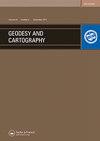利用数字高程模型研究伊朗西南部沙巴赞地区部分地区与滑坡评价相关的流域形态、稳定性和饱和带识别
IF 2.1
Q3 REMOTE SENSING
引用次数: 21
摘要
西南跨伊朗铁路线连接伊朗德黑兰和西南部的霍拉姆沙赫尔,穿越大扎格罗斯山脉。这条线路上的一个地点是沙赫巴赞火车站。Shahbazan站位于伊朗西南部扎格罗斯带中部的Alwar部分。复杂的地质地貌活动造成了不成熟和崎岖的景观,这反过来又给人类和铁路基础设施带来了各种自然灾害(滑坡、侵蚀和山洪暴发)。为了在区域尺度上解决这些问题,我们将数字高程模型(DEM)与选定的实地考察相结合,在实地考察期间,观察和测量了与岩性(倾角、走向和岩石类型)、结构(节理、裂缝、断层和褶皱)、土壤类型、土地利用和土地覆盖相关的各种参数。为了创建DEM,使用了伊朗测量组织编制的数字地形图。利用文本格式的x、y、z属性计算DEM。该方法包括一个交互式视觉校准,在参考观测到的滑坡时调整参数。在野外数据的基础上,对DEM进行标定,生成研究区针对滑坡等自然灾害的稳定带图和饱和带图。通过对流域地貌图、地形图和饱和度图的分析,揭示了研究区内的稳定-不稳定和饱和带与滑坡和岩崩带是一致的。然而,研究也表明,DEM为快速评估自然灾害和绘制大面积地图提供了一个有用的工具,而且时间短,效果好。本文章由计算机程序翻译,如有差异,请以英文原文为准。
Use of Digital Elevation Model for Study of Drainage Morphometry and Identification Stability and Saturation Zones in Relations to Landslide Assessments in Parts of the Shahbazan Area, SW Iran
The south-western trans Iranian railway line connecting Tehran, Iran to Khoramshahr in the southwest crosses the great Zagros range. One of the localities on this line is the Shahbazan railway station. Shahbazan station is located in the Alwar section of the central Zagros belt in the southwest of Iran. Complex geological-geomorphological activities have created an immature and rugged landscape which in turn imposes various natural hazards (landslide, erosion and flash flooding) to both people and the railway infra-strucutre. In order to address these problems on a regional scale, a digital elevation model (DEM) was used in conjunction with selected field visits during which various parameters related to lithology (dip, strike and rock types), structures (joints, fracturres, faults and folds), soil types, landuse and land cover were obsereved and measured. For the creation of a DEM, a digital topographic map prepared by the Iranian Surveying Organization was used. The DEM was computed using x, y, z attributes in text format. The methodology includes an interactive visual calibration that adjusts parameters while referring to observed landslides. Based on field data collected, the DEM was calibrated to generate stability zone map and saturation zone map of the study area which address to natural hazards like landslide. The analyses of drainage morphometery, relief and saturation maps reveals zones of stability-instability and saturation within the study area which are in harmony with landslide and rock fall zones. However, the study also indicates that the DEM provides a useful tool for rapid evaluation of natural hazards and mapping of large areas with less time and good results.
求助全文
通过发布文献求助,成功后即可免费获取论文全文。
去求助
来源期刊

Geodesy and Cartography
REMOTE SENSING-
CiteScore
1.50
自引率
0.00%
发文量
0
审稿时长
15 weeks
期刊介绍:
THE JOURNAL IS DESIGNED FOR PUBLISHING PAPERS CONCERNING THE FOLLOWING FIELDS OF RESEARCH: •study, establishment and improvement of the geodesy and mapping technologies, •establishing and improving the geodetic networks, •theoretical and practical principles of developing standards for geodetic measurements, •mathematical treatment of the geodetic and photogrammetric measurements, •controlling and application of the permanent GPS stations, •study and measurements of Earth’s figure and parameters of the gravity field, •study and development the geoid models,
 求助内容:
求助内容: 应助结果提醒方式:
应助结果提醒方式:


